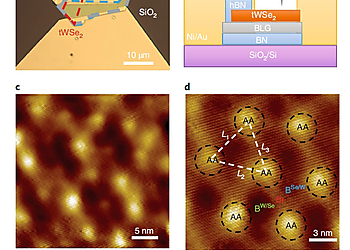Flat Bands in Twisted Bilayer Transition Metal Dichalcogenides
Result of the Month
The crystal structure of a material creates a periodic potential that electrons move through giving rise to its electronic band structure. When two-dimensional materials are stacked, the resulting moiré pattern introduces an additional periodicity so that the twist angle between the layers becomes an extra degree of freedom for the resulting heterostructure. As this angle changes, the electronic band structure is modified leading to the possibility of flat bands with localized states and enhanced electronic correlations. In transition metal dichalcogenides, flat bands have been theoretically predicted to occur for long moiré wavelengths over a range of twist angles around 0° and 60° (ref. 4) giving much wider versatility than magic-angle twisted bilayer graphene. Here, we show the existence of a flat band in the electronic structure of 3° and 57.5° twisted bilayer WSe2 samples using scanning tunnelling spectroscopy. Our direct spatial mapping of wavefunctions at the flat-band energy show that the localization of the flat bands is different for 3° and 57.5°, in agreement with first-principles density functional theory calculations.
Authors: Zhiming Zhang 1, Yimeng Wang 2, Kenji Watanabe 3, Takashi Taniguchi 3, Keiji Ueno 4, Emanuel Tutuc 2 and Brian J. LeRoy 1
Institutes:
1) Physics Department, University of Arizona, Tucson, AZ, USA
2) Microelectronics Research Center, Department of Electrical and Computer Engineering, The University of Texas at Austin, Austin, TX, USA
3) National Institute for Materials Science, Tsukuba, Ibaraki, Japan
4) Department of Chemistry, Graduate School of Science and Engineering, Saitama University, Saitama, Japan
Name and email of corresponding author:
Brian J. LeRoy, University of Arizona, leroy@arizona.edu

